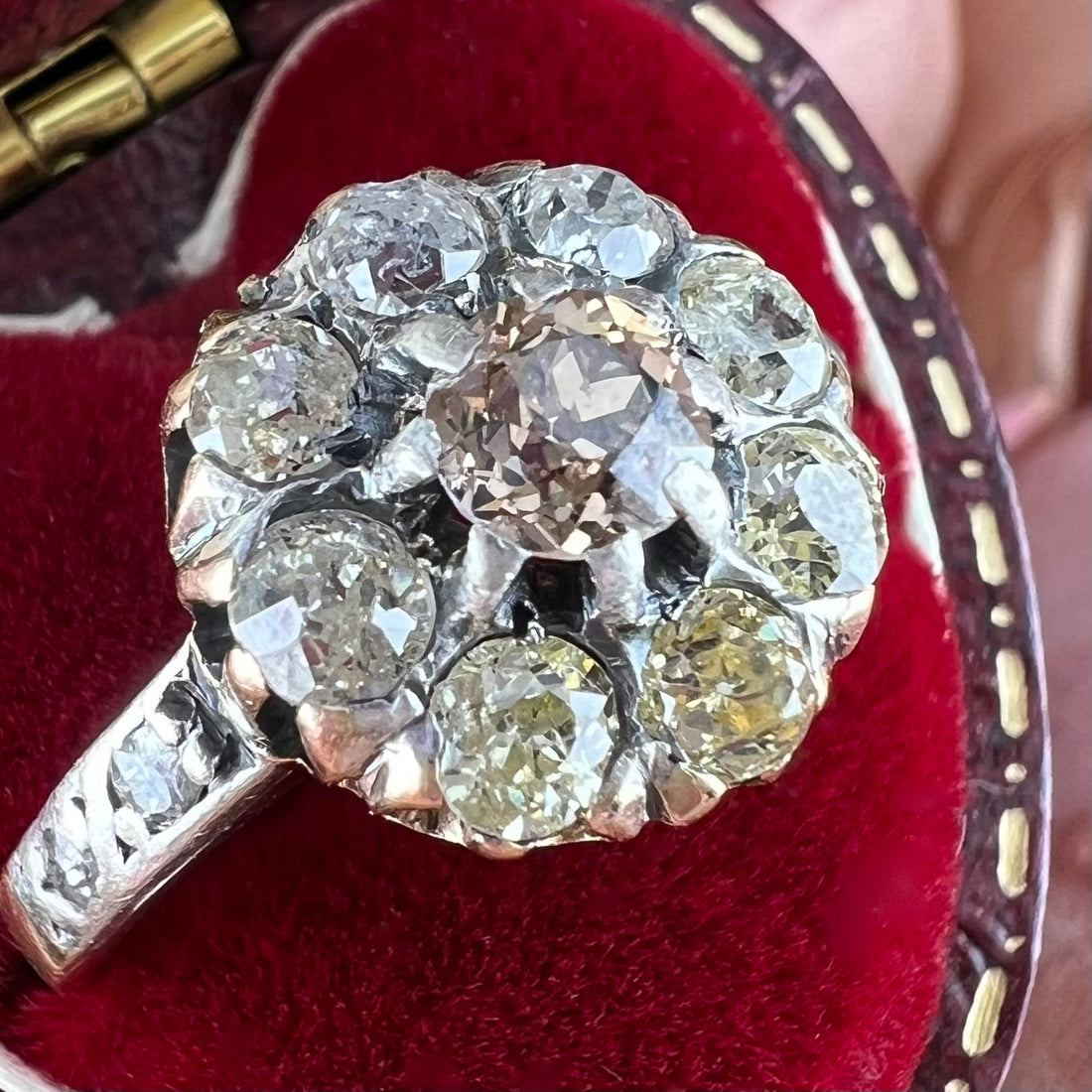Old-cut diamonds truly have a fascinating story to tell and unique visual characteristics that distinguish them from modern cuts.
Studying their origins and distinctive characteristics can certainly enrich the understanding and appreciation of these unique gems.
The name "old mine cut" or “old mine cut” is linked to the origin of diamonds and the history of the first mines, or rather the first alluvial deposits discovered in India and Brazil.
Long before the discovery of African mines in 1866-67.
Diamonds from these regions were much more limited in number than those from more modern African mines.
This limited availability, their particular cut and their variety of colors give these ancient diamonds a unique charm and a great added value for collectors and lovers of antique jewelry.
THE CUT
The diamond cutters of the old mining days were true artists.
Each stone was individually assessed and carefully cut to maximize its brilliance and color, creating jewels that would capture attention even under less favorable lighting conditions, such as candles or gas lamps.
The hand-cutting process ensured that each diamond was unique, with facets and proportions specifically tailored to the stone's characteristics, giving them a distinctive beauty and value.
The open “culet” and the square “cushion” shape are typical characteristics of diamonds of this era.
Diamond cutters of that time took inspiration from the natural shape of the diamond crystal and sought to optimize its brilliance and beauty like a sculptor carving his work from a block of marble according to its characteristics.
The presence of an unpolished girdle around the stone is another sign that distinguishes these antique diamonds.
They generally feature a smaller table, a high crown and a deep pavilion, which contribute to their distinctive aesthetic.
While they already have the same number of facets as modern round brilliants (58 facets), the facets of ancient mineral cuts are typically larger and more geometric, creating an enchanting play of light and a more distinctive appearance than modern brilliant cuts, which tend to have smaller, more precise facets.
These facets give them a particular charm and a softer and more romantic brightness compared to the modern one which appears colder.
Imperfections, rather than being considered defects, add character and authenticity, making each antique diamond a unique and precious piece.
The expert cutters of that time between 1700 and 1800 had an incredible mastery in transforming rough diamonds into finely crafted jewels, demonstrating an excellent precision technique that is still admired today by experts and collectors increasingly eager to possess these precious gems.
These now rare diamonds dominated the market from the 18th to the 19th century, until the late 19th century when the Old European cut took over.
The old European cut then paved the way for the modern brilliant cut that has definitively shaped the way we think about mass-produced diamonds today.
Old-mine diamonds offer a unique beauty that goes beyond the classic four Cs (Carat, Cut, Clarity and Color).
Their characteristics, such as their irregular shape, their peculiar facets and the way they reflect light, are aspects that deserve special attention.
COLOR
The color of old mine diamonds can vary greatly and should not be considered a disadvantage.
Each diamond carries its own characteristic color, which can be more pronounced than in modern diamonds.
Rather than focusing on predefined standards of color clarity, it is important to appreciate and evaluate the color of the stone based on personal preference and the context of the jewelry in which it will be placed.
The color of the “old mine” diamond adds character and authenticity to its intrinsic beauty.
Assessing the color of antique diamonds can be erroneous or even inappropriate using modern standards. Many of these diamonds may fall into the "J," "K," "L," or "M" categories of the current grading system, but it's important to consider the historical context in which they were mined and cut.
At that time, the mines that produced the whitest rough diamonds had not yet been discovered, although very white "old mine" specimens are rarely found. Furthermore, cutters of that era adapted cutting techniques specifically for each stone to enhance its individual color and brilliance, so even diamonds with lower letter grades could appear white to observers.
This adds significant value to these ancient diamonds, reflecting the care and skill that has gone into maximizing their natural beauty.
Lighting conditions play a fundamental role in the appearance of antique diamonds. They were designed to sparkle in dimly lit environments such as candles or gas lamps, offering a particularly captivating sparkle under these conditions.
By being able to examine the diamond under different lighting conditions, such as daylight, fluorescent light, incandescent light, and even candlelight, you can fully appreciate their beauty.
Old mine cut diamonds are rare antiques and carry an aura of history and tradition. When purchasing an old mine cut diamond, it's important to consider its uniqueness and historical and artistic value, as well as its distinctive characteristics compared to a modern machine-cut or even lab-created diamond.
The diamond cutting process of the old mines has significantly shaped the art and technique of diamond cutting.
CONCLUSIONS
Purchasing an antique diamond for those who are sensitive to land mining also helps reduce the demand for newly mined diamonds, offering a more sustainable and ethical solution and will always and in any case be a natural diamond rather than one created in a laboratory.
So a beautiful antique gemstone allows you to respect nature without negatively impacting the environment and without the risk of running into synthetic gems.
Antique diamonds carry a sense of history and uniqueness that makes them truly special.
Every old-mine diamond has a story to tell and an intrinsic beauty that reflects its long journey through time.
Their rarity and provenance give them an irresistible allure, making them true investment treasures to be treasured and admired, with their unique cuts exuding timeless elegance and beauty.
As you may have understood, diamonds extracted from old mines were rare already in the 18th century and obviously today there are fewer of them than in the 20th century and even fewer than those from modern intensive extraction.
Being among the lucky owners of such gems guarantees and will increasingly guarantee an attractive investment in the world of antique collectible jewelry.


1 comment
Bellissimo ariticolo! Concordo pienamente con voi questi diamanti hanno una luce ed un fascino unici! È come tutti i gioielli antichi, hanno un bagaglio di storia che li rende ancor più preziosi.